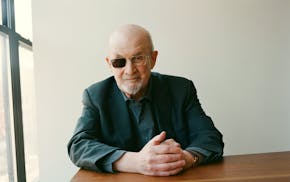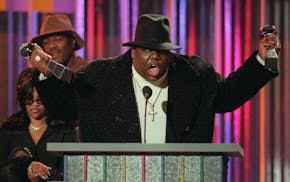For the first drawing, on March 24, Piotr Szyhalski grabbed what was handy. A sheet of paper, an ink brush and an image from his dream the night before: a severed head, plants sprouting from the eye sockets.
Then a phrase came to him, thanks to the news that morning that amid a growing pandemic, President Donald Trump promised "America will again and soon be open for business."
Szyhalski lettered it by hand: "Long live our banks!"
When he posted a photo of the poster-like, black-and-white work to his Instagram page @laborcamp, he had no idea what he'd started. How this drawing would lead to one more the next day, then another the day after that. How each day for the next 224 days, he would brainstorm, sketch, ink, photograph and post.
Daily dispatches confronting with anger and irony the country's handling of COVID-19.
"There were enough forces at work that kept me making the next one," said Szyhalski, 52, a longtime professor at the Minneapolis College of Art and Design.
Those forces, at times, were global. The drawings mark the growing number of COVID-19 cases and deaths like a drumbeat. But sometimes the forces were small, simple. A friend offered more ink. A nurse sent him a private message. A stranger posted what these drawings meant to her as she mourned her mother's death.
"There was this real connection with people who were right in the thick of it," Szyhalski said. "I was just in my basement, making some drawings every day.
"It was that connection that made me feel that it mattered somehow, that it was important to stay with them in some way."
That first drawing set the style for hundreds to come. With their directives — "Fight!" "Rise up!" "Keep 'em dying!" — and their symbols — hands, homes, dollar signs — many take the form of propaganda posters, skewering the federal government's response to the pandemic.
"The works are meticulous but piercing," the New York Times wrote, "like a carefully released primal scream."
That form is familiar to Szyhalski, who was born in Poland in 1967 and grew up surrounded by Communist propaganda and cultural posters with dual meanings. As a kid, he treasured a book of posters that soldiers crafted "crudely, simply, literally in the trenches" during World War II, he said.
"This piece of paper with some images and some words printed on it actually has this agency, has this power," Szyhalski said. "It's right there with the other guys hurling grenades."
He trained in Poland as a poster designer, drawing letterforms with a ruler and a compass, before moving to the United States in 1990 and Minneapolis in 1995. He became interested in the internet as a public space, nabbing national write-ups for being an early web-art whiz. In 1998 he launched Labor Camp, an ongoing art project in myriad mediums — music and media art, performance and printed ephemera — grappling with history, power and participation.
Its mantra: "We are working all the time!"
For his 2015 show at the now-defunct Soap Factory, he turned one gallery into a print shop, where attendees helped make massive banners carried during protests over the police killing of Jamar Clark.
So when the COVID-19 crisis hit, Szyhalski tuned in quickly to its language of war, to its economic underpinnings, to the labor of "essential," but underpaid, workers.
"It's sort of crazy to say, but I genuinely believe I've been practicing for my project my entire life," he said. "There's no doubt in my mind that I was able to step into this situation and do what I ended up doing because of everything I've done prior to it."
His daily routine
It became a regimen. Each morning, after rising at 5:30, he'd read the news. On small notecards and in an iPhone file, he'd jot down words or phrases that struck him as strange or important, shuffling them around.
Shut it down. Subjugate. Outbreak.
"News shrapnel," he said. "Amid the bits and pieces that keep flying, those are the ones that stick in my head."
Having learned English as a second language gives Szyhalski a bit of distance. How a word looks — its symmetry and its rhythm — might matter more than how it's spelled. Material to be shaped and organized.
In his basement studio, next to a photo of his mother in her nurse's uniform, he'd sketch, draw and, a few hours later, bring the finished poster to his daughter, Ava, who would hold it up on their porch, wearing a mask and blue gloves. Then he'd post it to Facebook and Instagram.
He never missed a day. A few times, his family went camping — leaving only after he'd finished a poster and returning the next day with enough time for him to do the next one.
Some posters are a gut-punch, others a poem.
With each, he'd pause for a moment or two and ask himself: Is this 100% true to me?
"The landscape, such as it is these days, is saturated with this demolished idea of truth or fact," he said. "We are craving for some sense of earnest connection. I needed to be sure, on my end, that that is present in the work."
When, in late May, George Floyd died after a police officer knelt on his neck for nearly nine minutes, Szyhalski sat with it. "I kept thinking: How do these things connect?"
"I can't breathe!" he lettered atop a stark rendering of 38th Street and Chicago Avenue. "If it's not COVID, it's the police."
He also called a former colleague, Colette Gaiter, an artist, graphic designer and professor at the University of Delaware. Gaiter, who is Black, discouraged one of his ideas and encouraged another.
That call shows Szyhalski's wisdom and empathy, she said. Gaiter credits that partly to his being an émigré, something that's palpable in his work, as well. Gaiter, who studies war posters, sees Szyhalski's project as a political tool that toys with those traditions.
"He's a smart observer of what is wrong with this country," she said.
Spreading the message
A few months in, former students and complete strangers started asking whether they could post the drawings in their own cities, on their own blocks.
Prints have popped up in New York and Los Angeles, and Portland and Philadelphia. Folks have messaged Szyhalski: Were you in Portland? But Szyhalski hasn't posted — or even seen — a poster in the wild.
A curator in Baltimore, Joseph Del Pesco, had watched the daily dispatches and asked himself: What's the best way to present these works, which grapple with massive, shared issues?
The city streets just made sense, Del Pesco said. "The public space is especially well-suited to things that don't necessarily swallow easy, things that are a little pointed, critical questioning." There, debate can occur.
In July, just as the sun was setting, an anonymous team of five people wheat-pasted dozens of Szyhalski's posters on traffic boxes along Charles Street, an artery that offers a cross-section of Baltimore. They prompted conversations online and on the street, Del Pesco said. Some posters that were critical of the police "got almost instantly defaced."
Screens can flatten and blur, he noted. In person, the posters looked more handmade, more powerful.
At some point, as Szyhalski's project gathered momentum, it seemed to move and grow almost autonomously.
"I was just tending to it," Szyhalski said. "It was more like a garden or something."
He loves it when that happens. When protesters use his materials to print their own banners. When volunteers paste his images in cities across the country. When a former student reaches out and, a few Zoom meetings and a Kickstarter campaign later, a book is in the works.
"It's always a learning experience and a humbling experience to realize the work has its own life."
But, as he returned to teaching at MCAD in the fall, the daily drawings took a toll, physically and emotionally. Several times, mid-drawing, "involuntarily, the tears would come out of my eyes," he said. "There was something about the circumstance, about the situation we all found ourselves in, that was just so exhausting."
He knew, too, that the election would change the project's scope and tone.
So, on Nov. 3, just before the election and after a dozen calls to "Vote!" Szyhalski submitted his final report. A hand turning the page to reveal a blank page ahead.
Jenna Ross • 612-673-7168 • @ByJenna
NPR suspends editor who criticized his employer for what he calls an unquestioned liberal worldview

Salman Rushdie's 'Knife' is unflinching about his brutal stabbing and uncanny in its vital spirit

